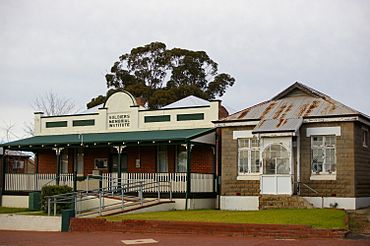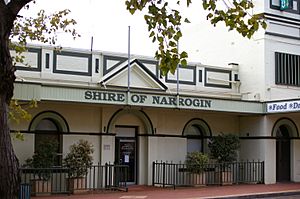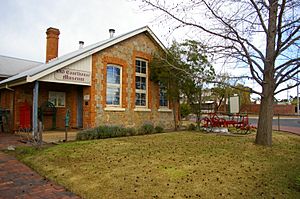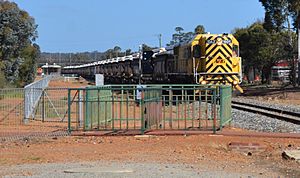Narrogin facts for kids
Quick facts for kids NarroginWestern Australia |
|||||||||
|---|---|---|---|---|---|---|---|---|---|

Soldier memorial institute
|
|||||||||
| Established | 1890s | ||||||||
| Postcode(s) | 6312 | ||||||||
| Elevation | 192 m (630 ft) | ||||||||
| Area | [convert: needs a number] | ||||||||
| Location | |||||||||
| LGA(s) | Shire of Narrogin | ||||||||
| State electorate(s) | Roe | ||||||||
| Federal Division(s) | O'Connor | ||||||||
|
|||||||||
Narrogin is a town in the Wheatbelt region of Western Australia. It is about 192 kilometers (119 miles) southeast of Perth. You can find it on the Great Southern Highway, between the towns of Pingelly and Wagin. Long ago, when steam engines were common, Narrogin was a very important railway center in southern Western Australia.
Contents
Discovering Narrogin's Past
Narrogin gets its name from an Aboriginal word. The name was first written down in 1869 for a waterhole in the area. What the name means exactly is not fully known. Some people say it means "bat camp," while others think it means "plenty of everything." It might also come from "gnargagin," which means "place of water."
Early Explorers and Settlers
The first Europeans to visit the Narrogin area were Alfred Hillman and his group in 1835. They were mapping a path between Perth and Albany. They passed about 10 kilometers (6 miles) west of where Narrogin is today. Later, shepherds sometimes brought their sheep to the area to find good grass.
People started settling in the Narrogin area in the 1860s and 1870s. These early settlers were mostly pastoralists, meaning they raised livestock like sheep. They lived in small, spread-out groups. Because there were so few people, there was no need to build a town at first.
Narrogin officially became a town in June 1897. It was then made a municipality (a town with its own local government) in April 1906. Life was hard for farmers in the early days. They often cut sandalwood trees or used bark from mallee trees to make money. This helped them when their wheat and sheep farms didn't earn much. By early 1898, about 60 people lived in the town.
Narrogin's Railway History
The arrival of the Great Southern Railway in July 1889 was a big moment for Narrogin. The railway company needed good places to get water for their trains on the way from Perth to Albany. The company bought the Narrogin waterhole, and the town grew up around it.
Narrogin became a central point for railways, connecting to six different places. Trains could travel from Narrogin to York, Wagin, Collie, Wickepin, Kulin, and Boddington.
Decline of the Railway Center
Narrogin was a major railway hub until the late 1970s. At that time, more goods started being moved by road instead of by train. This meant fewer people were needed to work on the railway. By 1987, Narrogin's railway importance had greatly decreased. Passenger trains stopped serving the station in 1978. The number of railway workers dropped from about 280 to fewer than 12 by 1995.
Narrogin Today
Even though the railway isn't as busy, Narrogin's past as a major railway junction helped it grow. Many businesses that support farming and government offices are located here. The town has good public services, especially in health and education. These services help Narrogin be an important regional center today.
Old Courthouse Museum
The Old Courthouse Museum is a popular place for visitors. This building was designed by an architect named George Temple-Poole and built in 1894. It was first used as a school until 1905. Then, it became the local courthouse. For a while, it housed a bank, but in 1970, it became a courthouse again. Since 1976, the building has been a museum. It shows off many interesting items from the region's history.
Farming and Agriculture
The areas around Narrogin are important for farming. Farmers grow wheat and other cereal crops here. The town is a receival site for Cooperative Bulk Handling. This means it's a place where farmers can deliver their grain after harvest.
Narrogin's Climate
Narrogin has a Mediterranean climate. This means it has hot, dry summers and cool, wet winters.
The hottest temperature ever recorded in Narrogin was 44.7 degrees Celsius (112.5 degrees Fahrenheit) on February 3, 2007. The coldest temperature was -3.1 degrees Celsius (26.4 degrees Fahrenheit) on September 6, 1956. Narrogin's highest daily rainfall happened on January 29, 1990, when 150.0 millimeters (5.9 inches) of rain fell.
| Climate data for Narrogin (climate data: 1891–2012) | |||||||||||||
|---|---|---|---|---|---|---|---|---|---|---|---|---|---|
| Month | Jan | Feb | Mar | Apr | May | Jun | Jul | Aug | Sep | Oct | Nov | Dec | Year |
| Record high °C (°F) | 43.7 (110.7) |
44.7 (112.5) |
40.9 (105.6) |
36.1 (97.0) |
32.2 (90.0) |
26.2 (79.2) |
22.2 (72.0) |
26.3 (79.3) |
36.4 (97.5) |
37.8 (100.0) |
42.1 (107.8) |
43.2 (109.8) |
44.7 (112.5) |
| Mean daily maximum °C (°F) | 31.0 (87.8) |
30.2 (86.4) |
27.3 (81.1) |
23.0 (73.4) |
18.5 (65.3) |
15.4 (59.7) |
14.6 (58.3) |
15.3 (59.5) |
17.7 (63.9) |
21.0 (69.8) |
25.5 (77.9) |
28.9 (84.0) |
22.4 (72.3) |
| Mean daily minimum °C (°F) | 14.1 (57.4) |
14.3 (57.7) |
13.0 (55.4) |
10.4 (50.7) |
7.9 (46.2) |
6.4 (43.5) |
5.3 (41.5) |
5.1 (41.2) |
6.0 (42.8) |
7.4 (45.3) |
10.1 (50.2) |
12.3 (54.1) |
9.4 (48.9) |
| Record low °C (°F) | 4.3 (39.7) |
3.9 (39.0) |
3.3 (37.9) |
−0.4 (31.3) |
−2.4 (27.7) |
−2.7 (27.1) |
−2.7 (27.1) |
−2.7 (27.1) |
−3.1 (26.4) |
−1.7 (28.9) |
0.0 (32.0) |
1.8 (35.2) |
−3.1 (26.4) |
| Average rainfall mm (inches) | 12.8 (0.50) |
15.9 (0.63) |
20.6 (0.81) |
29.8 (1.17) |
62.9 (2.48) |
87.1 (3.43) |
87.7 (3.45) |
67.8 (2.67) |
46.1 (1.81) |
31.4 (1.24) |
18.2 (0.72) |
14.1 (0.56) |
494.1 (19.45) |
| Average rainy days | 2.3 | 2.9 | 3.7 | 6.3 | 11.0 | 14.6 | 15.6 | 14.2 | 11.3 | 8.5 | 5.2 | 3.0 | 98.6 |
| Source: Bureau of Meteorology | |||||||||||||
Sports and Recreation
Narrogin has a strong connection to sports. In 1951, the Australian Grand Prix car race was held on a 7.1-kilometer (4.4-mile) track through the town's streets. About 35,000 people came to watch! Warwick Pratley won the race in an Australian-made car. An annual race meeting also took place on a shorter 3.5-kilometer (2.2-mile) track starting in 1948. Car racing in Narrogin stopped after a big accident at another race in 1955.
Today, Narrogin is a center for sports in the area. The town has improved its sports facilities with the Narrogin Leisure Complex. This complex has a 25-meter indoor heated swimming pool, a fun leisure pool, a gym, and squash courts. It also has basketball stadiums and a top-notch hockey field with a special wet surface.
Famous People from Narrogin
Many well-known people have connections to Narrogin:
- Barry Cable: A famous Australian Rules Football player for Perth and North Melbourne.
- Albert Facey (1894–1982): The author of the famous book A Fortunate Life, who lived in Narrogin for a time.
- Bevan George: A field hockey player who won a gold medal with the Australian Men's Team at the 2004 Summer Olympics in Athens.
- Brian Glencross: A retired Australian field hockey player and coach of the Australian Women's Team.
- Brad Hogg: A retired Australian cricketer, who played for the Melbourne Renegades and the Perth Scorchers.
- Shaun Marsh: An Australian cricketer and the older son of retired cricketer Geoff Marsh.
- Matthew Tonts: A Professor of Geography at The University of Western Australia. He is also the Chair of the Western Australian Environmental Protection Authority. He was born and grew up in Narrogin.
- Mudrooroo: A novelist, poet, essayist, and playwright, who was born in Narrogin.
- Rex T. Prider (1910–2005): A Professor of Geology at the University of Western Australia. He was born and grew up in Narrogin.
- Stephen Smith: An Australian Labor Party politician.
See also
 In Spanish: Narrogin para niños
In Spanish: Narrogin para niños





